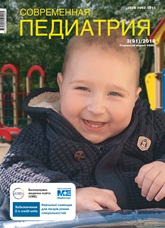Эффективность гепатопротекторной терапии бетаин-аргининовым комплексом «бетаргин» при применении у детей с неалкогольной жировой болезнью печени
DOI:
https://doi.org/10.15574/SP.2018.91.102Ключевые слова:
дети, ожирение, неалкогольная жировая болезнь печени, бетаин, аргинин, гепатопротекторное действие, лечениеАннотация
Статья посвящена проблеме профилактики развития неалкогольной жировой болезни печени (НАЖБП) у детей с ожирением по алиментарно-конституциональному типу. Целью работы было изучение эффективности и безопасности использования бетаин-аргининового комплекса для нормализации основных метаболических процессов углеводного и жирового обмена у детей с ожирением с целью профилактики развития и прогрессирования стеатогепатоза. Под наблюдением находились 70 детей с избыточной массой тела. Проведен полный спектр клинических, лабораторных и инструментальных исследований, позволяющих диагностировать НАЖБП на ранних стадиях развития. Детям с избыточной массой тела с целью профилактики развития НАЖБП в терапию включен бетаин-аргининовый комплекс «Бетаргин». Эффективность действия средства установлена на основании клинических, лабораторных и инструментальных исследований, проведенных после завершения терапии.Библиографические ссылки
Velichko VІ. (2011). Features of the epidemiology of childhood obesity in the south of Ukraine. Child health. 7: 52-56.
Stepanov JuM, Abaturov OЕ, Zavgorodnja NJu, Skirda ІJu. (2015). Non-alcoholic fatty liver disease in children: a modern look at the possibilities of diagnosis and treatment (Part II). Gastroenterology. 2(56): 58-67.
Anstee QM, Day CP. (2015, Aug). The Genetics of Nonalcoholic Fatty Liver Disease: Spotlight on PNPLA3 and TM6SF2. Semin Liver Dis. 35(3): 270—90. https://doi.org/10.1055/s-0035-1562947.
Araujo AR, Rosso N, Bedogni G et al. (2018, Feb). Global epidemiology of non-alcoholic fatty liver disease/non-alcoholic steatohepatitis: What we need in the future. Liver Int. 38; Sup 1: 47—51. https://doi.org/10.1111/liv.13643.
Arrese M, Feldstein AE. (2017, Apr). Nash-Related Cirrhosis: An Occult Liver Disease Burden. Hepatol Commun. 1(2): 84—86. https://doi.org/10.1002/hep4.1033.
Bush H, Golabi P, Younossi ZM. (2017, Jun 9). Pediatric Non-Alcoholic Fatty Liver Disease. Children (Basel). 4(6). pii: E48. https://doi.org/10.3390/children4060048.
Chalasani N, Younossi Z, Lavine JE et al. (2012, Jun). The diagnosis and management of non-alcoholic fatty liver disease:practice Guideline by the American Association for the Study of Liver Diseases, American College of Gastroenterology, and the American Gastroenterological Association. Hepatology. 55(6): 2005—23. https://doi.org/10.1002/hep.25762.
Clemente MG, Mandato C, Poeta M, Vajro P. (2016, Sep 28). Pediatric non-alcoholic fatty liver disease: Recent solutions, unresolved issues, and future research directions. Clemente. World J Gastroenterol. 22(36): 8078—93. https://doi.org/10.3748/wjg.v22.i36.8078.
Ekstedt M, Hagstrom H, Nasr P et al. (2015, May). Fibrosis stage is the strongest predictor for disease-specific mortality in NAFLD after up to 33 years of follow-up. Hepatology. 61(5): 1547—54. https://doi.org/10.1002/hep.27368.
Eslam M, George J. (2016, May). Genetic and epigenetic mechanisms of NASH. Hepatol Int. 10(3): 394—406. https://doi.org/10.1007/s12072-015-9689-y.
Eslam M, Valenti L, Romeo S. (2018, Feb). Genetics and epigenetics of NAFLD and NASH: Clinical impact. J Hepatol. 68(2): 268—279. https://doi.org/10.1016/j.jhep.2017.09.003.
Friedewald WT, Levy RI, Fridrickson DS. (1972, Jun). Estimation of the concentration of low-density lipoprotein cholesterol in plasma, without use of the preparative ultracentrifuge. Clin Chem. 18(6): 499—502. PMid:4337382.
Greydanus DE, Greydanus DE, Agana M, Kamboj MK et al. (2018, Apr). Pediatric obesity: Current concepts. Dis Mon. 64(4): 98—156. https://doi.org/10.1016/j.disamonth.2017.12.001.
Jacobs RL, van der Veen JN, Vance DE. (2013, Oct). Finding the balance: the role of S-adenosylmethionine and phosphatidylcholine metabolism in development of nonalcoholic fatty liver disease. Hepatology. 58(4): 1207—9. https://doi.org/10.1002/hep.26499.
Jolliffe CJ, Janssen I. (2007, Feb 27). Development of age-specific adolescent metabolic syndrome criteria that are linked to the Adult Treatment Panel III and International Diabetes Federation criteria. J Am Coll Cardiol. 49(8): 891—8. https://doi.org/10.1016/j.jacc.2006.08.065.
Khoonsari M, Mohammad Hosseini Azar M, Ghavam R et al. (2017, Spring). Clinical Manifestations and Diagnosis of Nonalcoholic Fatty Liver Disease. Iran J Pathol. Spring. 12(2): 99—105.
Lewis JR, Mohanty SR. (2010, Mar). Non-alcoholic Fatty Liver Disease: A Review and Update. Dig Dis Sci. 55(3): 560—78. https://doi.org/10.1007/s10620-009-1081-0.
Lin MS, Lin TH, Guo SE et al. (2017, Oct 30). Waist-to-height ratio is a useful index for nonalcoholic fatty liver disease in children and adolescents: a secondary data analysis. BMC Public Health. 17(1): 851. https://doi.org/10.1186/s12889-017-4868-5.
Nobili V, Donati B, Panera N et al. (2014, May). A 4-polymorphism risk score predicts steatohepatitis in children with nonalcoholic fatty liver disease. J Pediatr Gastroenterol Nutr. 58(5): 632–6. https://doi.org/10.1097/MPG.0000000000000279.
Pappachan JM, Babu S, Krishnan B, Ravindran NC. (2017, Dec 28). Non-alcoholic Fatty Liver Disease: A Clinical Update. J Clin Transl Hepatol. 5(4): 384—393. https://doi.org/10.14218/JCTH.2017.00013.
Perumpail BJ, Khan MA, Yoo ER et al. (2017, Dec 21). Clinical epidemiology and disease burden of nonalcoholic fatty liver disease. World J Gastroenterol. 23(47): 8263—8276. https://doi.org/10.3748/wjg.v23.i47.8263.
Ratziu V, Bellentani S, Cortez-Pinto H et al. (2010, Aug). A positionstatement on NAFLD/NASH based on the EASL 2009 special conference. J Hepatol. 53(2): 372—84. https://doi.org/10.1016/j.jhep.2010.04.008.
Schwimmer JB, Behling C, Newbury R et al. (2005, Sep). Histopathology of pediatric nonalcoholic fatty liver disease. Hepatology. 42(3): 641—9. https://doi.org/10.1002/hep.20842.
Seko Y, Yamaguchi K, Itoh Y. (2018, Apr). The genetic backgrounds in nonalcoholic fatty liver disease. Clin J Gastroenterol. 11(2): 97—102. https://doi.org/10.1007/s12328-018-0841-9.
Smolka V, Ehrmann JJr, Tkachyk O et al. (2014). Relation of risk factors between metabolic syndrome and nonalcoholic fatty liver disease in children and adolescents. Cas Lek Cesk. 153; 2: 91—97. PMid:24797780
Sumida Y, Yoneda M. (2018, Mar). Current and future pharmacological therapies for NAFLD/NASH. J Gastroenterol. 53(3): 362—376. https://doi.org/10.1007/s00535-017-1415-1.
Tseng PH, Liu CJ, Kao JH et al. (2008, Oct). Disease progression in a patient with nonalcoholic steatohepatitis. J Formos Med Assoc.107(10): 816—21. https://doi.org/10.1016/S0929-6646(08)60196-5.
Ued Fda V, Weffort VR. (2013, Dec). Antioxidant vitamins in the context of nonalcoholic fatty liver disease in obese children and adolescents. Rev Paul Pediatr. 31(4): 523—30. https://doi.org/10.1590/S0103-05822013000400016.
Valenti L, Alisi A, Galmozzi E et al. (2010, Oct). I148M patatin-like phospholipase domain-containing 3 gene variant and severity of pediatric nonalcoholic fatty liver disease. 52(4): 1274—80. doi 10.1002/hep.23823.
Younossi Z, Anstee QM, Marietti M et al. (2018, Jan). Global burden of NAFLD and NASH: trends, predictions, risk factors and prevention. Nat Rev Gastroenterol Hepatol. 15(1): 11—20. https://doi.org/10.1038/nrgastro.2017.109.

